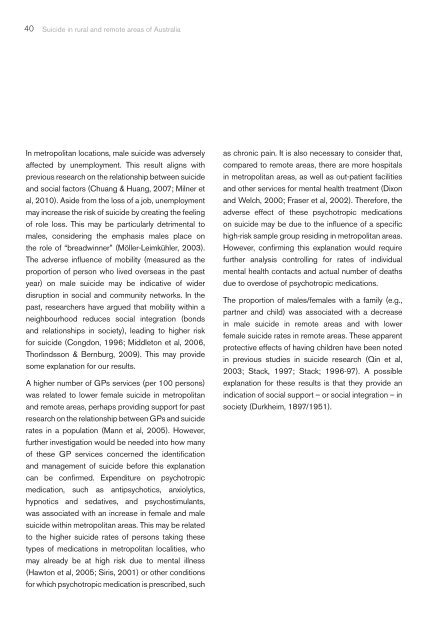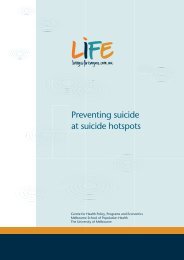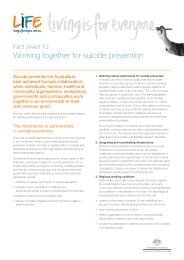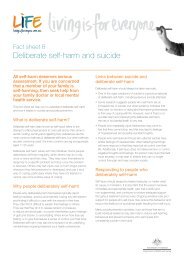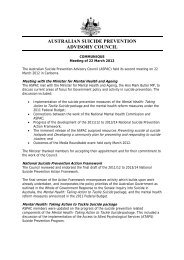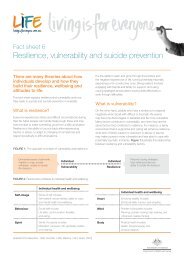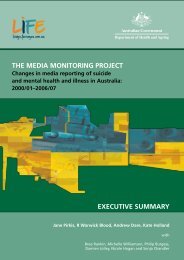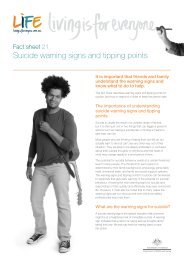SUICIDE in RURAL & REMOTE AREAS of AUSTRALIA - Living is for ...
SUICIDE in RURAL & REMOTE AREAS of AUSTRALIA - Living is for ...
SUICIDE in RURAL & REMOTE AREAS of AUSTRALIA - Living is for ...
You also want an ePaper? Increase the reach of your titles
YUMPU automatically turns print PDFs into web optimized ePapers that Google loves.
40<br />
Suicide <strong>in</strong> rural and remote areas <strong>of</strong> Australia<br />
In metropolitan locations, male suicide was adversely<br />
affected by unemployment. Th<strong>is</strong> result aligns with<br />
previous research on the relationship between suicide<br />
and social factors (Chuang & Huang, 2007; Milner et<br />
al, 2010). Aside from the loss <strong>of</strong> a job, unemployment<br />
may <strong>in</strong>crease the r<strong>is</strong>k <strong>of</strong> suicide by creat<strong>in</strong>g the feel<strong>in</strong>g<br />
<strong>of</strong> role loss. Th<strong>is</strong> may be particularly detrimental to<br />
males, consider<strong>in</strong>g the emphas<strong>is</strong> males place on<br />
the role <strong>of</strong> “breadw<strong>in</strong>ner” (Möller-Leimkühler, 2003).<br />
The adverse <strong>in</strong>fl uence <strong>of</strong> mobility (measured as the<br />
proportion <strong>of</strong> person who lived overseas <strong>in</strong> the past<br />
year) on male suicide may be <strong>in</strong>dicative <strong>of</strong> wider<br />
d<strong>is</strong>ruption <strong>in</strong> social and community networks. In the<br />
past, researchers have argued that mobility with<strong>in</strong> a<br />
neighbourhood reduces social <strong>in</strong>tegration (bonds<br />
and relationships <strong>in</strong> society), lead<strong>in</strong>g to higher r<strong>is</strong>k<br />
<strong>for</strong> suicide (Congdon, 1996; Middleton et al, 2006,<br />
Thorl<strong>in</strong>dsson & Bernburg, 2009). Th<strong>is</strong> may provide<br />
some explanation <strong>for</strong> our results.<br />
A higher number <strong>of</strong> GPs services (per 100 persons)<br />
was related to lower female suicide <strong>in</strong> metropolitan<br />
and remote areas, perhaps provid<strong>in</strong>g support <strong>for</strong> past<br />
research on the relationship between GPs and suicide<br />
rates <strong>in</strong> a population (Mann et al, 2005). However,<br />
further <strong>in</strong>vestigation would be needed <strong>in</strong>to how many<br />
<strong>of</strong> these GP services concerned the identifi cation<br />
and management <strong>of</strong> suicide be<strong>for</strong>e th<strong>is</strong> explanation<br />
can be confi rmed. Expenditure on psychotropic<br />
medication, such as antipsychotics, anxiolytics,<br />
hypnotics and sedatives, and psychostimulants,<br />
was associated with an <strong>in</strong>crease <strong>in</strong> female and male<br />
suicide with<strong>in</strong> metropolitan areas. Th<strong>is</strong> may be related<br />
to the higher suicide rates <strong>of</strong> persons tak<strong>in</strong>g these<br />
types <strong>of</strong> medications <strong>in</strong> metropolitan localities, who<br />
may already be at high r<strong>is</strong>k due to mental illness<br />
(Hawton et al, 2005; Sir<strong>is</strong>, 2001) or other conditions<br />
<strong>for</strong> which psychotropic medication <strong>is</strong> prescribed, such<br />
as chronic pa<strong>in</strong>. It <strong>is</strong> also necessary to consider that,<br />
compared to remote areas, there are more hospitals<br />
<strong>in</strong> metropolitan areas, as well as out-patient facilities<br />
and other services <strong>for</strong> mental health treatment (Dixon<br />
and Welch, 2000; Fraser et al, 2002). There<strong>for</strong>e, the<br />
adverse effect <strong>of</strong> these psychotropic medications<br />
on suicide may be due to the <strong>in</strong>fl uence <strong>of</strong> a specifi c<br />
high-r<strong>is</strong>k sample group resid<strong>in</strong>g <strong>in</strong> metropolitan areas.<br />
However, confi rm<strong>in</strong>g th<strong>is</strong> explanation would require<br />
further analys<strong>is</strong> controll<strong>in</strong>g <strong>for</strong> rates <strong>of</strong> <strong>in</strong>dividual<br />
mental health contacts and actual number <strong>of</strong> deaths<br />
due to overdose <strong>of</strong> psychotropic medications.<br />
The proportion <strong>of</strong> males/females with a family (e.g.,<br />
partner and child) was associated with a decrease<br />
<strong>in</strong> male suicide <strong>in</strong> remote areas and with lower<br />
female suicide rates <strong>in</strong> remote areas. These apparent<br />
protective effects <strong>of</strong> hav<strong>in</strong>g children have been noted<br />
<strong>in</strong> previous studies <strong>in</strong> suicide research (Q<strong>in</strong> et al,<br />
2003; Stack, 1997; Stack; 1996-97). A possible<br />
explanation <strong>for</strong> these results <strong>is</strong> that they provide an<br />
<strong>in</strong>dication <strong>of</strong> social support – or social <strong>in</strong>tegration – <strong>in</strong><br />
society (Durkheim, 1897/1951).<br />
GriffithBook FINAL 20/09.<strong>in</strong>dd 40<br />
15/11/12 4:28 PM


